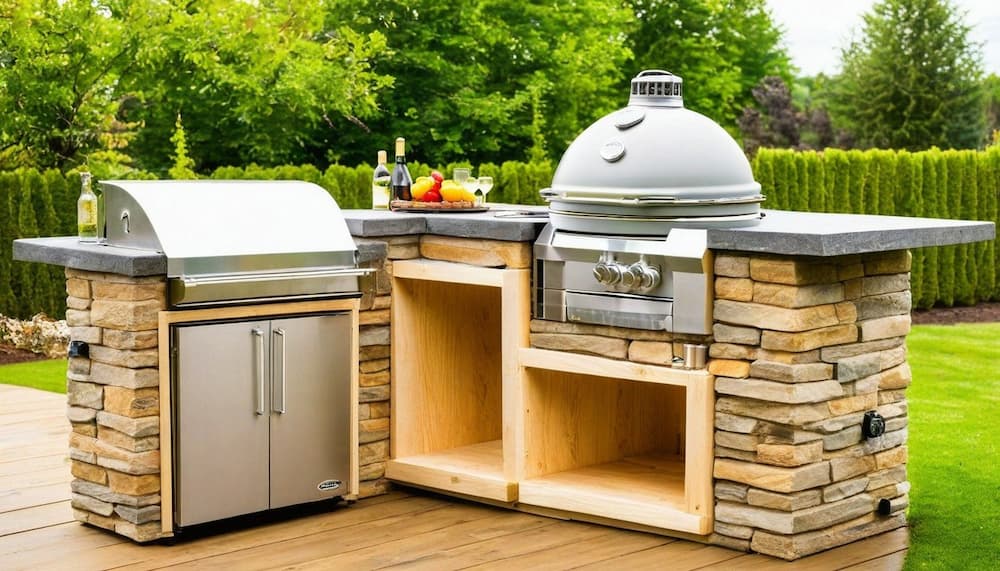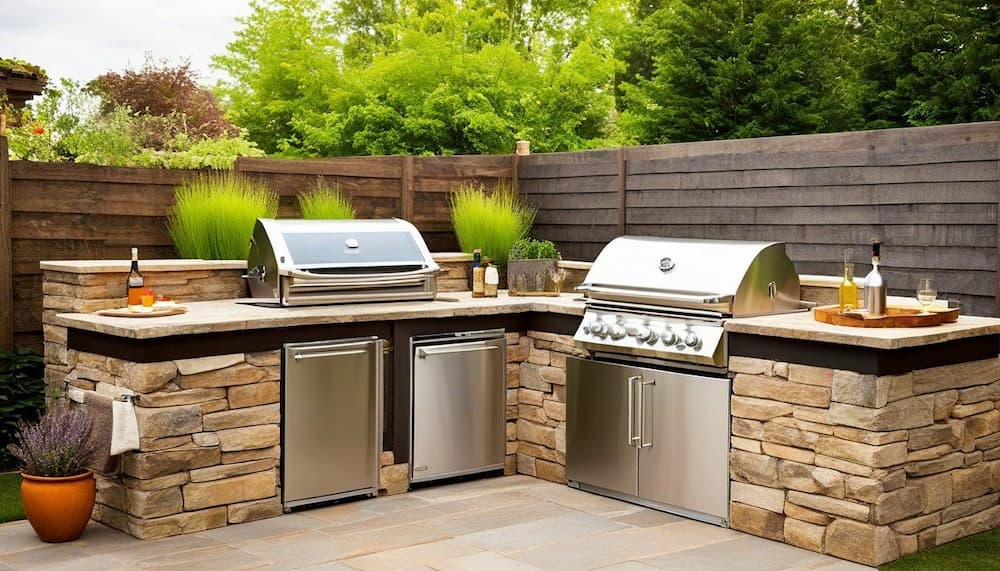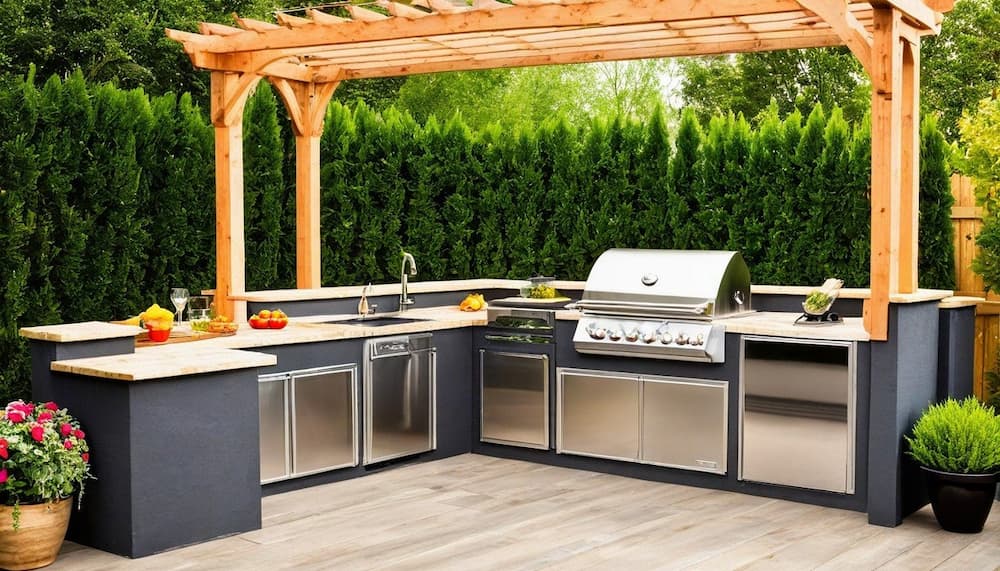As a passionate home cook, I have always dreamed of having my outdoor kitchen. The idea of preparing delicious meals while enjoying the fresh air and beautiful surroundings has always appealed to me. So, I decided to take matters into my own hands and build a DIY outdoor kitchen. In this article, I will share with you the benefits of building your outdoor kitchen, as well as the basics of planning, designing, and building one. Get ready to bring your culinary skills to the great outdoors!

Benefits of Building a DIY Outdoor Kitchen
Building a DIY outdoor kitchen comes with numerous benefits that can enhance your cooking experience. Firstly, it allows you to expand your living space. By creating an outdoor cooking area, you can make better use of your backyard and create a functional outdoor entertaining space. It becomes the perfect spot for hosting summer barbecues, family gatherings, and dinner parties under the stars.
Secondly, a DIY outdoor kitchen adds value to your home. Not only will it be a unique selling point when the time comes to put your property on the market, but it will also increase your enjoyment while living in your home. Potential buyers will be impressed by the added convenience and luxury of having an outdoor kitchen.
Lastly, cooking outdoors can have health benefits. Grilling and smoking food are healthier cooking methods compared to frying or baking. The excess fat drips away, resulting in leaner and healthier meals. Additionally, being outside in the fresh air and sunlight can boost your mood and overall well-being.
Planning Your DIY Outdoor Kitchen
Before you start building your DIY outdoor kitchen, it is crucial to have a well-thought-out plan. Begin by assessing your available space and considering the layout and flow of your outdoor area. Take into account the proximity to your indoor kitchen, seating areas, and any existing structures, such as a patio or deck.
Next, determine the size and shape of your outdoor kitchen. Consider how many people you will typically be cooking for and what appliances and features you want to include. Do you envision a simple grill station or a fully equipped kitchen with a sink, refrigerator, and pizza oven? Make a list of your must-haves and prioritize them based on your budget and available space.
Once you have a clear idea of your desired layout and features, it is time to create a detailed plan. Measure your space accurately and sketch out your outdoor kitchen design. This will help you visualize the final result and ensure that everything fits seamlessly into your outdoor space.
Essential Elements of a DIY Outdoor Kitchen

Now that you have a plan in place, let’s dive into the essential elements that make up a DIY outdoor kitchen. These elements will not only enhance the functionality of your outdoor cooking area but also contribute to its aesthetic appeal.
- Grill or cooking station: The heart of any outdoor kitchen is the grill or cooking station. Choose a high-quality grill that suits your cooking preferences and budget. Consider factors such as fuel type (gas, charcoal, or electric), cooking surface size, and additional features like side burners or rotisseries.
- Countertop space: Sufficient countertop space is essential for food preparation, plating, and serving. Choose a durable material that can withstand outdoor elements and is easy to clean, such as granite, concrete, or stainless steel. Ensure that you have enough space for both cooking and dining purposes.
- Storage: Incorporating ample storage is crucial to keep your outdoor kitchen organized and functional. Include cabinets, drawers, and shelves to store cooking utensils, tools, and other essentials. Opt for weather-resistant materials that can withstand exposure to the elements.
Choosing the Right Materials for Your DIY Outdoor Kitchen
When it comes to building your DIY outdoor kitchen, selecting the right materials is crucial to ensure its durability and longevity. As your outdoor kitchen will be exposed to various weather conditions, it is essential to choose materials that can withstand the elements and require minimal maintenance.
For the framework and structure of your outdoor kitchen, opt for materials such as stainless steel or weather-resistant treated wood. These materials are sturdy and can endure the outdoor environment. Avoid using regular untreated wood, as it may rot or warp over time.
When it comes to countertops, you have a variety of options. Granite and concrete are popular choices due to their durability and resistance to heat and stains. If you prefer a more natural look, consider using stone or tile. Whichever material you choose, ensure that it is sealed properly to prevent damage from moisture and UV exposure.
For the flooring of your outdoor kitchen, select a slip-resistant material that can withstand heavy foot traffic and exposure to the elements. Popular options include concrete, stone pavers, or outdoor-rated tiles. These materials are not only durable but also provide a stylish and cohesive look to your outdoor space.
Design Considerations for Your DIY Outdoor Kitchen

Designing your DIY outdoor kitchen involves more than just selecting appliances and materials. It is an opportunity to create a space that reflects your style and complements your outdoor environment. Consider the following design considerations to ensure that your outdoor kitchen is as visually appealing as it is functional.
- Aesthetic cohesion: Aim for a cohesive design that seamlessly integrates your outdoor kitchen with the rest of your backyard. Consider the architectural style of your home and choose materials, colors, and finishes that complement it. This will create a visually harmonious space that feels like a natural extension of your indoor living area.
- Lighting: Proper lighting is essential for both safety and ambiance. Incorporate a combination of task lighting, such as under-counter lights for food preparation, and ambient lighting, such as string lights or wall sconces, to create a warm and inviting atmosphere. Additionally, consider installing lighting fixtures that are specifically designed for outdoor use to ensure durability.
- Shade and shelter: Depending on your climate and personal preferences, you may want to incorporate shade and shelter features into your outdoor kitchen design. This could include a pergola, retractable awning, or built-in umbrella. These additions will provide relief from the sun and allow you to use your outdoor kitchen in various weather conditions.
Building Your DIY Outdoor Kitchen – Step-by-Step Guide
Now that you have completed the planning and design phases, it’s time to roll up your sleeves and start building your DIY outdoor kitchen. Follow this step-by-step guide to ensure a successful construction process.
- Prepare the site: Clear the area where your outdoor kitchen will be located. Remove any existing structures, vegetation, or debris. Ensure that the ground is level and stable.
- Build the framework: Start by constructing the framework for your outdoor kitchen. This will provide the structure and support for your appliances and countertops. Use weather-resistant treated wood or stainless steel studs to create the framework according to your planned layout.
- Install utilities: If your outdoor kitchen requires utilities such as water, gas, or electricity, now is the time to install them. Consult with professionals to ensure proper installation and compliance with local codes and regulations.
- Install appliances and countertops: Once the framework and utilities are in place, it’s time to install your appliances and countertops. Follow the manufacturer’s instructions for each appliance and use a level to ensure everything is properly aligned.
- Connect utilities: If you have installed utilities, connect them to your appliances following the appropriate safety procedures. Consult with professionals if you are unsure about any aspect of the installation.
- Add finishing touches: To complete your DIY outdoor kitchen, add the finishing touches that will enhance its functionality and visual appeal. This could include installing a backsplash, adding seating options, or incorporating decorative elements that reflect your style.
Adding Finishing Touches to Your DIY Outdoor Kitchen

As you near the completion of your DIY outdoor kitchen, it’s time to add those final touches that will elevate its functionality and aesthetics. Consider the following ideas to put the finishing touches on your outdoor culinary oasis:
- Seating: Create a comfortable seating area near your outdoor kitchen. This could be in the form of built-in benches, outdoor dining furniture, or lounge chairs. Choose weather-resistant materials and cushions for durability and comfort.
- Decorative elements: Add decorative elements that reflect your style and enhance the overall ambiance of your outdoor kitchen. This could include potted plants, outdoor artwork, string lights, or a water feature. Be creative and make your outdoor kitchen a true reflection of your personality.
- Outdoor kitchen accessories: Invest in high-quality accessories that will make your outdoor cooking experience more enjoyable and efficient. This could include a grill cover, cooking utensils, a fire extinguisher, or a weatherproof Bluetooth speaker for entertainment.
Maintenance and Care for Your DIY Outdoor Kitchen
To ensure the longevity and optimal performance of your DIY outdoor kitchen, regular maintenance and care are essential. Follow these tips to keep your outdoor kitchen in top shape:
- Clean regularly: Clean your outdoor kitchen regularly to remove any grease, food residue, or dirt. Use warm soapy water and a soft cloth or sponge to clean countertops, appliances, and surfaces. Avoid using abrasive cleaners that can damage the materials.
- Protect from the elements: When not in use, protect your outdoor kitchen from the elements. Use covers or tarps to shield your appliances and countertops from rain, snow, and UV rays. This will help prevent damage and extend their lifespan.
- Inspect for damage: Periodically inspect your outdoor kitchen for any signs of damage or wear. Look for cracks in countertops, loose connections, or rust on appliances. Address any issues promptly to prevent further damage and ensure safety.
Conclusion
Building a DIY outdoor kitchen is a rewarding project that can enhance your cooking experience and create a functional and stylish entertaining space. By carefully planning, selecting the right materials, and following a step-by-step guide, you can bring your culinary dreams to life. So, grab your spatula and get ready to cook in style in your very own DIY outdoor kitchen!
